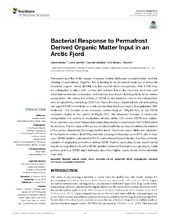| dc.contributor.author | Müller, Oliver | |
| dc.contributor.author | Seuthe, Lena | |
| dc.contributor.author | Bratbak, Gunnar | |
| dc.contributor.author | Paulsen, Maria Lund | |
| dc.date.accessioned | 2018-09-20T12:20:54Z | |
| dc.date.available | 2018-09-20T12:20:54Z | |
| dc.date.issued | 2018-08-06 | |
| dc.identifier.issn | 2296-7745 | en_US |
| dc.identifier.uri | https://hdl.handle.net/1956/18526 | |
| dc.description.abstract | The warming of the Arctic causes increased riverine discharge, coastal erosion, and the thawing of permafrost. Together, this is leading to an increased wash out of terrestrial dissolved organic matter (tDOM) into the coastal Arctic ecosystems. This tDOM may be anticipated to affect both carbon and nutrient flow in the microbial food web and microbial community composition, but there are few studies detailing this in Arctic marine ecosystems. We tested the effects of tDOM on the bacterial community composition and net-growth by extracting DOM from the active layer of permafrost soil and adding the aged tDOM concentrate to a natural microbial fjord community (Kongsfjorden, NW Svalbard). This resulted in an increased carbon load of 128 μM DOC in the tDOM treatment relative to the control of 83 μM DOC. We observed changes in community composition and activity in incubations already within 12 h where tDOM was added. Flow cytometry revealed that predominantly large bacteria increased in the tDOM treated incubations. The increase of this group correlated with the increase in relative abundance of the genus Glaciecola (Gammaproteobacteria). Glaciecola were initially not abundant in the bacterial community (0.6%), but their subsequent increase up to 47% after 4 days upon tDOM addition compared to 8% in control incubations indicates that they are likely capable of degrading permafrost derived DOM. Further, according to our experimental results we hypothesize that the tDOM addition increased bacterivorous grazing by small protists and thus tDOM might indirectly also effect higher trophic levels of the microbial food web. | en_US |
| dc.language.iso | eng | eng |
| dc.publisher | Frontiers | en_US |
| dc.relation.ispartof | <a href="http://hdl.handle.net/1956/18525" target="blank">Implications of a changing Arctic on microbial communities: Following the effects of thawing permafrost from land to sea</a> | en_US |
| dc.rights | Attribution 4.0 International (CC BY 4.0) | eng |
| dc.rights.uri | https://creativecommons.org/licenses/by/4.0/ | eng |
| dc.title | Bacterial Response to Permafrost Derived Organic Matter Input in an Arctic Fjord | en_US |
| dc.type | Peer reviewed | |
| dc.type | Journal article | |
| dc.description.version | publishedVersion | en_US |
| dc.rights.holder | Copyright the Author(s) | en_US |
| dc.source.articlenumber | 263 | |
| dc.identifier.doi | https://doi.org/10.3389/fmars.2018.00263 | |
| dc.source.journal | Frontiers in Marine Science | |
| dc.source.40 | 5 | |
| dc.subject.nsi | VDP::Matematikk og Naturvitenskap: 400::Zoologiske og botaniske fag: 480::Marinbiologi: 497 | en_US |

